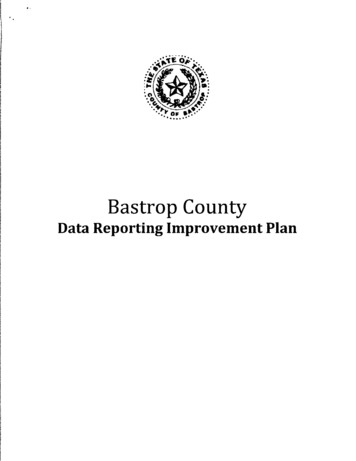
Transcription
I . .'Bastrop CountyData Reporting Improvement Plan
IIII.': "" ';:-,.Bastrop County Data Reporting Improvement Plani:Jf-ttl. .W. \.' :·- .JI ''"'' Section I- Legislative RequirementChapter 60.10, Code of Criminal Procedure (CCP) creates provisions regarding a datareporting improvement plan applicable to a county that has an average dispositioncompleteness percentage, including both juvenile and adult dispositions, of less than 90percent. The statute requires the Commissioners Court of such a county to establish alocal data advisory board, as described by state law, not later than November I, 2009.The bill sets forth the persons authorized and required to be included in such a local dataadvisory board. The statute requires a local data advisory board to prepare a datareporting improvement plan, in addition to other duties prescribed by law, and requiresthat plan to describe the manner in which the county intends to improve the county'sdisposition completeness percentage; ensure that the county takes the steps necessary forthe county's average disposition completeness percentage to be equal to or greater than90 percent in the first report DPS submits to certain state officers and agencies regardinglocal jurisdiction reporting on or after January I, 2013; and include a comprehensivestrategy by which the county will permanently maintain the county's dispositioncompleteness percentage at or above 90 percent. The statute requires a local dataadvisory board established under the bill's provisions, not later than June I, 2010, tosubmit to DPS the data reporting improvement plan prepared for the county. DPS, onreceipt of a data reporting improvement plan, is required to post the plan on the DPSInternet website. The statute authorizes the public safety director ofDPS to adopt rulesconcerning the contents and form of a data reporting improvement plan.In compliance with this statute, the Bastrop County Commissioners Court established alocal data advisory board on October 26, 2009.It is the goal of this advisory board to develop and implement procedures to ensureaccurate and complete reporting of all reportable arrests, prosecutor actions, and courtdispositions that occur in the county.Section II- Composition of the Local Advisory Board MembersThe Board consists of the following members, selected using the requirements of Chapter60.10, CCP. The Commissioner's Court chose to create the board using the positiontitles outlined in Chapter 60, rather than appointing specific individuals to the board.These positions and the individuals filling them are listed below.Roberta Godward, Sheriffs designeeBarbara Bogart, Assistant District AttorneyTheresa Stoppel berg and Esther Coy, District Attorney Employees who handle CJISRose Pietsch and Cindy Germano, County Clerk and Deputy County ClerkCathy Smith and Marisa Rendon, District Clerk and Deputy District ClerkDonna Pierce, designee of the Chief of Police of the City of BastropKen Cruise, IT Administrator2
· ·j.'tltOJ;· .'t \Bastrop County Data Reporting ImprovementPlan; .,.,f,!i'Additional input was contributed from the following persons responsible for collecting,storing, reporting, and using data and they are also members of the Board and their inputwas very valuable:Chris Bratton, Chief of Police of the Elgin Police DepartmentBarbara Coy, Adult Probation DepartmentCrystal Relf, Juvenile Probation DepartmentAny vacancies occurring on the board will be replaced by nomination and popular vote ofthe remaining members of the board.Section III - Current Process Supporting the Chapter 60 ReportingRequirementsWhenever a reportable arrest takes place in Bastrop County, the jail fingerprints thearrestee on an electronic fingerprint system which reports the tracking number (TRN)assigned through our Jail Management System. This tracking number is used by theprosecutor of the case to submit whether the case is accepted or rejected, and by the courtto submit the final case disposition to the Department of Public Safety ComputerizedCriminal History system (DPS CCH). Certain Key functions have been identified by DPSand are examined below along with a more detailed description of the reporting process.How the DPS Incident Tracking Number (TRN) and Tracking NumberSuffix (TRS) are introduced into and maintained throughout the flow ofinformationAll Class B Misdemeanor, Class A Misdemeanor, and Felony arrests for offensesidentified by DPS as reportable offenses and made in Bastrop County on local warrantsor on-view arrests are reported to DPS so they may be included in the person'scomputerized criminal history (CCH). The officer making the arrest completes a paperbooking sheet which lists the specific DPS offense code for the charge on which theindividual is arrested. This booking sheet is given to the jailer who uses this form to enterthe charge information into our Jail Management System, which creates the initialtracking number (TRN) for the arrest and forwards it electronically to the fingerprintsystem, which in tum electronically transmits the arrest data to DPS. This trackingnumber is passed to each department that deals with the case in electronic format.Subjects arrested by Smithville or Elgin Police Departments are printed and a TRNassigned and sent to DPS by that agency. We receive a copy of that CR-43, manuallyenter their TRN# into our Jail Management System, and electronically print, but do notsubmit fingerprints to DPS.How persons arrested on out of county warrants are processedSince the agency issuing the warrant is responsible for submitting the arrest informationto DPS, no information is sent to DPS by Bastrop County when an out of county warrantis served. Individuals arrested on warrants from other counties are electronically3
···j."itii;·.· \.Bastrop County Data Reporting ImprovementPlan i'},,,,fl'fingerprinted without submission. The fingerprint cards are printed and placed with theprinted CR-43 in the inmate's jail file. If the issuing agency picks up the inmate, the CR 43 and print card go with them. If the inmate bonds, the jail records technician sends theCR-43 to the warrant holder along with the fingerprints and the defendant or bondpaperwork. This allows the warrant holder to complete the CR43 and submit theinformation by mail to DPS.How persons arrested out of county on in-county warrants areprocessedIf an individual is arrested out of county on a local warrant, one of two cases may occur.If the arrestee does not bond out and Bastrop County picks the subject up, he is booked into our jail when he arrives and the arrest is submitted to DPS through our system just assomeone arrested on a local warrant. If, however, the arrestee bonds out before beingtransferred to Bastrop County, the Jail Records Technician should receive the paperworkfrom the arresting agency. This paperwork should contain a fingerprint card and partiallycompleted CR43. If the received paperwork includes a CR-43 and fingerprints, the CR-43is completed by the Jail Records Technician and mailed to DPS with the fingerprint card,and the TRN is manually entered into the jail management system and forwarded to thecourts for updates.How added charges are dealt with so that they receive an appropriateTRS and reported to the next county entity and to the DPSIf there are multiple charges at the time of arrest, these are all entered on the same arrestTRN with different tracking suffixes (TRS), then the fingerprints are taken and thecharges are transmitted to DPS. The TRS 's are created by the jail management systemsoftware. If charges are added by the officers at a later time, these are submitted to theprosecutor as a separate case, and the prosecutor is responsible for submitting the newcharge, if accepted, to DPS. A new arrest is entered into the system, creating a new TRN,but the subject is notre-fingerprinted, so this TRN is not submitted to DPS, onlyforwarded electronically to the courts. New charges added by Law Enforcementimmediately at the time of arrest will have a TRS beginning with the letter 'A'. Chargesadded later by the prosecutor will have a TRS beginning with 'D'. If a charge is added bythe prosecutor's office to an existing arrest, that charge is submitted to DPS via directentry on the DPS EDR website by the prosecutor's CJIS entry person just before the caseis sent to the County or District Clerk's Office. Two paper copies of the CJIS record areprinted from the website after submission. One copy is placed in the case file in theprosecutor's office, and the other copy is forwarded to the County or District Clerk'sOffice. The TRN infonnation for added charges is put in the local case managementsystem by the County Clerk for County cases, if possible.How charges disposed by the arresting agency or prosecutor arereported to the next county agency and to the DPSBastrop County policy is that any on-view arrest will be submitted to the appropriateprosecutor as a case for review. If the arresting agency does not wish to pursue the case,4
I.·· ;. - . . , ··:., . .\.Bastrop County Data Reporting Improvement Plan·: ,,, 'they will still submit it to the prosecutor with that information attached. The prosecutor isthen responsible for submitting the arrest disposition through e-mail. These cases may bereported as dropped by arresting agency or rejected by prosecutor, but will be submittedto DPS by the prosecutor's office.Non-reportable arrests that are submitted to DPS in error are submitted by the JailRecords Technician to have the arrest closed out as charges dropped, submitted in error.How each agency ensures that all charges are reported to the nextcounty agency and to the DPSOn each arrest made and transmitted through Livescan, one paper copy of the arrestrecord (CR43) is printed and placed in the defendant's jail folder. The jailer alsomanually enters the booking information into Bastrop County's jail management system,which electronically forwards the CJIS information to the courts. The Jail RecordsTechnician picks up jail folders daily for arrestees who had bonded out ofjail and assuresthere is a correct CJIS copy in the jail record.For any cases that arrive without a CJIS form, the local case management system can bereviewed to verify if a local arrest took place. TRN information entered on the jailing inthe case management software by the Jaw enforcement personnel can be viewed by theCounty Attorney's Office.If received, the paper CJIS form is kept with the case as it is reviewed in the DistrictAttorney's Office. When the case is accepted or rejected it is, by recently establishedprocedure, given to the CJIS entry person in the District Attorney's Office and theprosecutor action is submitted to DPS via e-mail. If the case is rejected, no notification ofthe County Court occurs; however, Jaw enforcement is notified by paper form for bondand case management purposes.The District Attorney also receives the CR43 by e-mail and submits their action on thecharges through e-mail; however, unless they reject the case prior to Grand Jury, the DPSsubmission only occurs after the Grand Jury has returned a result. The TRN can still belocated for cases missing the CJIS paperwork through the local case management system.Both the County Clerk and District Clerk in Bastrop County receive TRN information bysearching the Jail Management System. TRN information entered on the jailing in thecase management software by the law enforcement personnel can be viewed by theCounty and District Clerk's Offices to verify this information. Both the County andDistrict Clerks submit the final disposition of their cases to DPS using e-mail. Anyamendments to probation terms or deferrals are also submitted by the DPS EDR websiteor e-mail, allowing dispositions to appear almost instantly in the person's CCH.Juvenile cases are forwarded by paper form (CR-43J) by the CID Secretary with theBastrop County Sheriffs Office to the Bastrop Juvenile Probation Officer. The probationofficer then fills in the intake, prosecutor and court sections of the CR-43J. This5
I\llII. .(;.'ie: iii · .i . . .; .w. ., :·· .J.I!Bastrop County Data Reporting Improvement Plan "''''"'paperwork is held until the case has been disposed. The probation officer then forwardsthe paper copy with the court disposition to the Bastrop County Prosecutor, where theinformation is submitted to DPS.For automated counties, how the DPS "Return File" is processed andused to enhance reportingBastrop County does not batch transmit arrest data or receive batch return files from DPSand is not currently receiving return files. Errors are not discovered until brought to usby a DPS representative, often months after the fact.Section IV- Problem Areas Associated with Compliance to Chapter 60ReportingBastrop County has identified many problem areas in the criminal history reportingprocess, and has been working to update procedures and equipment to prevent theseproblems. Many of these issues were identified and solutions begun before the creation ofthe Local Data Advisory Board; however, the board has helped communicate the overallprocess and assisted some departments in refining their policies to help improve CCHreporting.Electronic Fingerprint Machine ProblemsSeveral issues the Advisory Board identified resulted from problems in the jail using theelectronic finger print machine. Some of these problems were created by the hardwareitself, and made worse by lack of training, and others were caused by proceduralproblems.Livescan/Contract IssuesLivescan, the electronic fingerprint and reporting system in use at the jail, has had manyproblems in the past transmitting the arrest information to DPS. For several months,arrest data wasn't being transmitted, or was transmitted but was never being received byDPS. The error return files are also not being received by the jaiLReturn File Review Problems at JailJailers had not been trained to check the return file to determine if any errors were presentand to verify the transmission went to DPS successfully. If the error file is not checkedregularly by the jail and corrected and retransmitted, the arrest will not get in to DPS.When this happens, the prosecutor data cannot be entered into the DPS system until theproblem with the arrest data is fixed. This may cause the case to be moved through thesystem without the information being sent to DPS at the appropriate times.6
I. , ·til' "t,\.;· ·Bastrop County Data Reporting Improvement Plan· ·'''''·· ;Procedural issues at JailSometimes jailer workload will cause a record that has been entered into Livescan not tobe transmitted to DPS. When this occurs, the information is all in the local computer, butnever gets sent to DPS. As a result, the prosecutor cannot submit their actions since theTRN is not in DPS records yet.DPS Offense Code List Publication DelaysEspecially after legislative sessions, there are many new laws created and others changed.DPS reviews these changes and assembles the offense code list used by agencies. Whennew laws take effect in September, but are not published in the list until December,agencies cannot enter correct information. Officers have difficulty finding the properoffense code to correctly charge arrestees. This leads to inaccuracies in the CCH andproblems for prosecutors and courts when they have to submit their actions to DPS.DPS Procedurallssues-Delays & Missing PaperworkPaperwork must still occasionally be mailed in to DPS to create arrest records. If, forexample, the electronic fingerprint system goes down, arrestees are ink fingerprinted andlaw enforcement uses the carbon copy CR43 mailed to DPS to submit information. Itoften takes 40 days or more from mailing date until this record appears in the system.Prosecutors and Clerk's cannot submit any of their actions electronically until the recordappears in the CCH, creating paperwork delays that need procedures in place to preventnon-compliance. Also, if an error is found on a mailed in document, the document isreturned to the county for correction through the DPS CJIS representative for that region.These representatives may only visit semi-annually or less, delaying notification of anyerrors that need to be corrected.Recalled Warrants/Letters of Appearance/Out of County WarrantsOn cases where the arrestee has not had any fingerprints made, there will be no record inDPS. The prosecutor and courts cannot submit any information to DPS until fingerprintsare obtained and the DPS arrest record is created. This is also the case on out of countyarrests on in-county warrants, since if any prints are received they are usually not of thequality necessary to submit to DPS. If a case is dismissed before these prints are taken,the arrest may never be submitted to DPS. Also, if a person fails to appear in court, thearrest will not make it in the DPS CCH.Procedural IssuesWhen the jail received an arrestee from Elgin or Smithville, they were supposed toreceive a copy of their CR-43 on the arrest. When this was not received, some officersassumed that no CR-43 had been created and created a new TRN for submission,resulting in DPS returns as duplicate arrests. Since it is our TRN that is forwardedelectronically to the courts, this also resulted in the courts and prosecutors attempting toupdate duplicated records, rather than the correct TRN. TRNs created by policedepartments that are not reported to the jail are not entered into our system, so there is noTRN there for the courts to update.7
.tt. 'ff.!-, .:::Bastrop County Data Reportmg Improvement Plan .,, ,, ,. lIOne failure in the reporting to DPS and to the next agency from Bastrop County wascaused by a lack of procedure for case filing and missing paperwork in the case file. Priorto recently created procedures, the prosecutor manually filled in CJIS carbon copies andmailed them to DPS. If the CJIS forms were not in the case file, these papers were notsent in, and there was no procedure to locate the missing paperwork or verifY if therewas, in fact, a local arrest. Paperwork may be missing for several reasons, including thepapers being held at the jail if the defendant remained in custody without bonding out,papers being lost or not placed in correct files at the jail, papers being misplaced at lawenforcement, or papers being lost or misplaced when being transported to or from lawenforcement. The same problems affected the County and District Clerk's offices. If theCR43 paperwork was not in the file, there was not a set procedure and little effort wasmade to locate arrest paperwork or get fingerprints and submit the information to DPS.Sometimes the problem was not discovered until after the case had been disposed and thedefendant was no longer in contact with the court.Additional effort and research is required when paperwork is missing to prevent casesgetting filed without entry into the DPS CCH system. This is especially a problem onfelony charges, as the District Attorney's Office is remotely located, and does notcurrently have access to the local case management system. This prevents them frombeing able to verify arrests and identify cases where paperwork may be missing.Problems may also occur if the new procedures are not followed and cases bypass theCJIS data entry person for any reason. This may prevent the next department fromreceiving the hard copy CJIS paperwork with the TRN as well as preventing theprosecutor action from showing up in DPS.For out-of-county arrests on local warrants, the CR43 is rarely received with thispaperwork and the fingerprints, and if received, are usually poor qualities. When this isthe case, no information is submitted to DPS by our county from this paperwork.In addition, CR-43 forms and fingerprint cards that are mailed in cause lengthy delaysand no tracking ability to verify the information has been submitted until it appears inDPS records, which may take in excess of 45 days. If the defendant was arrested out ofcounty on a local warrant, there is generally no paperwork delivered to the prosecutor'soffice. The only notice received by the prosecutor comes from the court that the arrestwas made and the case needs to be set for a hearing. Law enforcement does not send anyinformation to the prosecutor.These arrests are not in DPS records. Currently felony case arrestees do not getfingerprinted until they are indicted or placed on probation. Once indicted, they willusually be fingerprinted and the arrest information will be transmitted to DPS throughLivescan. If the individual is placed on probation and no arrest information can be foundin DPS records, the probation department will have the person fingerprinted and will fillout a CR43P paper form and mail that in to DPS.8
Ili. ;:·.'!' \;\'Bastrop County Data Reporting Improvement Plan· ,, 'Section V - Remediation of ProblemsSome new procedures have already been put in place over the past year to solve theproblems experienced by Bastrop County. In addition, several hardware and policychanges have been identified as necessary and are in the process of being implemented.IJlIIIIIlIjiII!Electronic Fingerprint Machine ProblemsThe Jail Operations Lieutenant has been made aware of the reporting issues that originatefrom the jail. In response to hardware issues with the Livescan fingerprint system Our ITdepartment is working with DPS and DataWorks, our Livescan provider, to resolve thesubmission and return file issues. In addition, the jail has been made aware that errorreturn files must be checked and corrected immediately so the information is available forother departments to add their actions. Training of jailers is an ongoing effort to correctdata entry and human errors in this area.In addition to the officer who submits records to DPS checking return files for errors, thefollowing shift will also double-check all records for successful submission via the DPSwebsite. This should significantly reduce records with errors.DPS Offense Code List Publication DelaysThe county has been in contact with DPS regarding offense codes, and DPS has madeprogress in recent years correcting these codes and making the code list more accessible.The latest list has been loaded by our Livescan provider.DPS Procedural Issues-Delays & Missing PaperworkEffective June 2010, two copies of the CR43 will be printed for every reportable arrest.One will be placed in a file for the Patrol Secretary to pick up daily, and the other isplaced in the defendant's jail file for verification by the Jail Records Technician. Forarrests in on-view offenses by Bastrop County officers, the case file is held by the PatrolSecretary until the officer has provided them with the paperwork, evidence, and any othernecessary information for the case to be filed with the prosecutor. The Patrol Secretarythen delivers the papers to the prosecutor's office. For Bastrop County offenses, thesecase files are hand delivered in paper format. All case files submitted to the prosecutor'soffice will now include a copy of the CR43 if a local arrest was made.Changing the method of data transfer from the prosecutor's and clerk's offices to DPSfrom a mailed paper form to direct data entry on the DPS EDR website should alsogreatly improve compliance. This site makes instant verification of arrest data possibleand should eliminate the delay in finding and correcting errors. Also, the new DPS EDRwebsite will allow the County to perform a yearly review of open arrests and comparethese arrests to respective cases in the local case management system. In this way, arreststhat are not closed out when they should be are identified, and the cause of the problemcan be researched as well.9
.· oi;·j.'iEQ"j.·.,.Bastrop County Data Reporting Improvement Pla n'{U)Recalled Warrants/Letters of Appearance/Out of County WarrantsBastrop County is researching option to make fingerprinting available in the courts forthose arrests made on local warrants by out-of-county jurisdictions that have not beenreported to DPS prior to their court date.Procedural IssuesMany new procedures have been introduced to improve the communication of arrest datafrom one department to the next. One important procedural change is that all casessubmitted to the prosecutors and to the clerks must have a CR43 (or CJIS data printedfrom the DPS EDR website) ifthere was a local arrest. Offices are being reminded toreview all cases and if this paperwork is not attached, they are being asked to locate thepaperwork or discover why it is not attachedAt the office level, a CJIS data entry person in the prosecutor's office is now responsiblefor reviewing each case before it is filed in the County or District Clerk's office or closedas a rejected case.ConclusionThe Advisory Board was instrumental in bringing the various departments together todiscuss the procedure changes and the need for these changes. It also provided anopportunity for departments that had already implemented changes to share those withother departments and improve county reporting as a whole. Changes have been made inhardware, personnel training, reporting procedures and departmental transfer procedures.As of January 20 I 0, the procedures already implemented in Bastrop County brought theCounty into compliance with Chapter 60, CCP. The additional procedures put in placeand on the way should allow the County to maintain this compliance and improve on theaccuracy of the data submitted to DPS, thereby contributing toward our goal of completeand accurate reporting of all reportable offenses.Corrected version of Bastrop County's Plan approved the 14'h day of June, 2010.Commissioner William PifiaC sSioner John Klaus10
One copy is placed in the case file in the prosecutor's office, and the other copy is forwarded to the County or District Clerk's Office. The TRN infonnation for added charges is put in the local case management system by the County Clerk for County cases, if possible. How charges disposed by the arresting agency or prosecutor are










